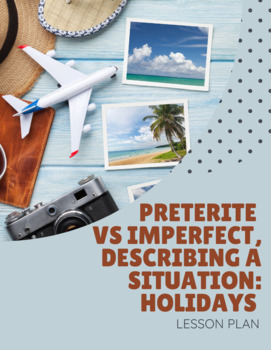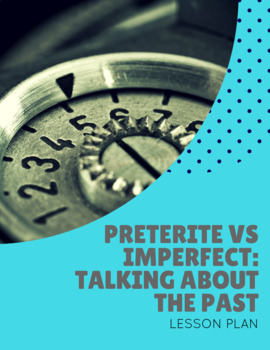
Students often confuse the preterite and imperfect tenses because they are both used to talk about past events, but in different contexts.
The preterite is used to talk about completed actions or events that happened in the past, while the imperfect is used to describe incomplete or habitual actions that occurred in the past.
It can be difficult to determine which tense should be used when trying to explain a particular situation. Additionally, overlapping uses of the two tenses can further complicate matters.
How Students Can Master the Preterite vs. the Imperfect
1. Teach the different uses for preterite and imperfect tenses. Generally, the preterite is used to describe completed actions in the past, while the imperfect describes incomplete or ongoing past actions.
Check out these Preterive vs Imperfect Spanish Lessons Plans for your high school students:
 Preterite vs Imperfect, Describing a Situation – Lesson Plan for Spanish 2 – Students learn vocabulary related to travel and vacations, and become familiar with some characteristics of Spanish from Spain and Argentina. Later, they will learn to alternate in a story the indefinite and the imperfect, to narrate and describe actions and situations in the past. Lastly, they will use the indefinite / imperfect contrast to narrate a family celebration or a trip to their partner, who will have to tell another partner about it later.
Preterite vs Imperfect, Describing a Situation – Lesson Plan for Spanish 2 – Students learn vocabulary related to travel and vacations, and become familiar with some characteristics of Spanish from Spain and Argentina. Later, they will learn to alternate in a story the indefinite and the imperfect, to narrate and describe actions and situations in the past. Lastly, they will use the indefinite / imperfect contrast to narrate a family celebration or a trip to their partner, who will have to tell another partner about it later.
-
 Preterite vs Imperfect – Talking About the Past Lesson Plan for Spanish 3 – Students express different nuances and meanings that have to do with the past by using the preterite and the imperfect appropriately. They will narrate what they did in the past; emphasizing the time it took place by using the preterite and describe past situations, emphasizing habitually by using the imperfect.
Preterite vs Imperfect – Talking About the Past Lesson Plan for Spanish 3 – Students express different nuances and meanings that have to do with the past by using the preterite and the imperfect appropriately. They will narrate what they did in the past; emphasizing the time it took place by using the preterite and describe past situations, emphasizing habitually by using the imperfect.
2. Tell students to pay attention to trigger words and expressions that indicate when to use a particular tense. For example, words such as “ayer” (yesterday) may indicate the use of the preterite tense; meanwhile, expressions such as “cuando tenía” (when I had) usually imply the use of the imperfect tense.
3. Present samples of sentences that use preterite or imperfect and observe how they are used in certain contexts. This will help you understand when to use either one more effectively. Songs in Spanish are a great authentic resources to see these difference.

Check some songs in Spanish to practice the preterite and the imperfect:
- En el río by Amaral
- Mi niñez by Joan Manuel Serrat
- No quise mirar by Carla Morrison
- 10 Songs in Spanish to Practice the Preterite and the Imperfect
4. Practice speaking and writing in Spanish using both tenses correctly, taking time to think through each sentence before you say it or write it down. The more they practice with Spanish tenses, the more comfortable they’ll use them correctly in conversation or writing.
Check out our list of Spanish Class Activities.

